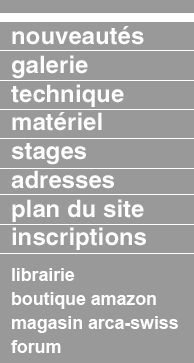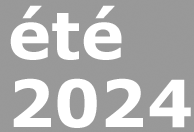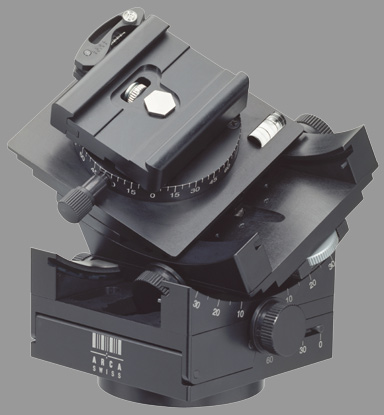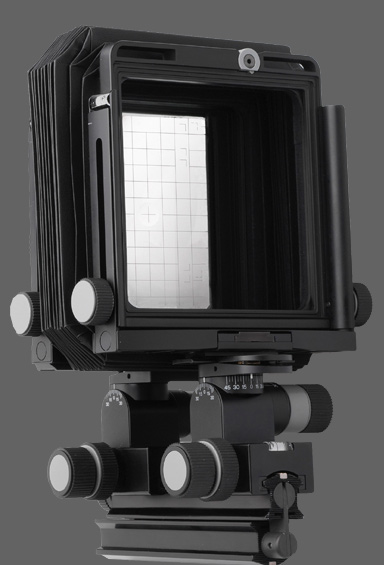|
|||||||||||||||||||||||||||

Tout le catalogue Arca-Swiss |
A visit to Arca Swiss International
October 2004 : like every two years, the photographic world meets in Cologne for the famous international photo fair and exhibition. At a time when the photographic industry is shattered by the digital revolution, no doubt, the Photokina itself is alive and well for many years to come. This year, the definite supremacy of small-format digital cameras over film cameras, any format, was supposed to be obvious in all display booths at the Photokina... nevertheless, several manufacturers have introduced this year new products in the field of medium and large format view/technical cameras for film or silicon image sensors; among them, Arca Swiss is upgrading nothing less than the whole F-line and M-line camera series with more compact models, with a reduced weight, up to the 8"x10" format. Most of us did not have the opportunity to go to Cologne for the Photokina, however a small group of galerie-photo readers and Large Format (LF) friends were happy to visit Arca Swiss International in Besançon (France) in November 2004 in order to see and touch new products presented in October in Germany and, a few days later, in New York. The aim of the visit, beyond the presentation of new products, was also of course to meet in person the Arca Swiss people, and to discuss directly with the owner of the company and designers of the Arca Swiss products. In a photographic world dominated by mass-produced cameras and accessories, one could think that it is a rare privilege, but in the large format photographic world, most manufacturers are actually small-size enterprises, direct contacts are easier. An appointment was made for a Saturday morning, end of November. Visitors came from Nîmes in the south of France, Moisenay near Paris, and Strasbourg and even from La Chaux de Fonds (Switzerland); in other words, the meeting was a truly international photographic meeting. The party is welcome by Philippe Vogt, the owner of Arca Swiss and designer of the F-line / M-line products, together with his son and faithful colleague in the company : Martin. Later, Mrs Vogt joins us at the table decorated for us with two misura® cameras : the "leather case" and the "metal shell".
|
||||||||||||||||||||||||||
|
|
|||||||||||||||||||||||||||
|
HistoryResisting temptation to immediately jump on new camera products on display nearby, the party starts a long conversation with the Vogt family. First of all, the history of the company. Philippe Vogt was only too willing to tell many good stories and good memories. At the beginning, in the years 1940-1950, there exists in Zürich a fine mechanics company owned by the Oschwald brothers (legal name : Gebrüder Oschwald) specialised in camera and photographic equipment repair as well as in the design and fabrication of precision mechanical products. As far as fine mechanics is concerned, the Oschwald brothers have, of course, several customers in the photographic industry, but not only there. Private individual customers can ask them for special optical and mechanical products. In his childhood, Philippe Vogt already knows the Oschwald brothers very well; his father is one of the private customers of the Oschwald company for all kinds of custom-made opto-mechanical devices and adaptors for medical micro-photography. In the middle of the 1950's, the Oschwald brothers decide to start their own product line of system monorail view cameras. A first trademark is found, a German acronym, but it is already the property of a famous European photographic company. Another trademark is found, an Anglo-Saxon acronym : ARCA, meaning All-Round-CAmera, a general-purpose large format camera system ready for all kinds of photographic jobs. If you look for the single keyword "Arca" on the Internet, you'll find many references totally irrelevant to the large format photographic world, for example you'll find an international architecture magazine. Therefore the registered trademark was eventually chosen as : Arca Swiss. Arca Swiss large format cameras are since the beginning composed of interchangeable parts : focusing rails, bellows, function carriers (or function supports, a literal translation from the German Funktionsträger, a terminology due to Arca Swiss), format frames, lens boards, ground glass holders, all basic elements of the system that can be combined just as you like for many configurations and many formats. This basic principle of unit assembly, as mentioned by Kerry Thalmann in a recent article [1] with interchangeable parts is identical today with modern F-line and M-line cameras, but the products have been significantly improved since the first models of the 1950's. After introducing their monorail cameras, the Oschwald brothers continue to design several speciality cameras, some of them are based on common elements to the monorail system, like 6x9 and 4"x5" single lens reflex cameras, as well as very specialised products like a panoramic rotating drum camera for the 120 rollfilm in the same spirit as the present Roundshot® manufactured by Seitz Fototechnik AG. Before he joins and eventually becomes the manager of Arca Swiss Fototechnik AG, Philippe Vogt knows the photographic industry very well. He has worked with most view/technical cameras available on the professional market in the 1970's. At the beginning of the 1980's, he joins the Oschwald brother's company and soon hereafter he starts a new industrial story with the acquisition of Arca Swiss in 1984 when the Oschwald brothers wish to sell their assets and retire. At the beginning, Philippe Vogt's position as en employee is a bit uncomfortable since he knows the qualities but also the limitations of Oschwald Brothers' Arca Swiss cameras. He has to improve the products as well as production methods but he also has to preserve backward compatibility with the existing system. New computer-numerically-controlled (CNC) machine-tools are bought, the new F-line and M-line cameras are created. They differ from the previous, pre-1984 cameras, by substituting metal to plastic for format frames, by improving light-tight seals in the edge on lens-boards, now made by precision milling instead of compressed foam, a complete redesign of the mechanism of function carriers which are still compatible with old rails. New F-line/M-line cameras, thanks to redesigned format frames, can now more easily handle wide-angle lenses with very short focal lengths, a domain of photographic optics where progress have been spectacular between 1950 and 1980. New CNC machines allow to fabricate mechanical parts with tighter tolerances, and where half a dozen manually-operated machines were necessary, a single CNC machine produces as many parts with greatly improved tolerances and precision; tighter tolerances being a key point in the success of a photographic camera system with interchangeable parts. At the 1984 Photokina, new cameras are introduced, first the M-line series: the first M-line model, the "MFM" (multi-functions module) offers as soon as 1984 electronic measurements for tilts and shifts in all axes, allowing a precise setup of the camera through a computer interface. Soon follow the F-line series, then the Monolith series and eventually the Metric series which offer the same size as the F-line but with all geared, precise self-locking micrometric movements. The Monoball tripod head is totally redesigned and receives the famous aspherical ball, another example of the capabilities in CNC machining coupled with the last improvements in materials and surface treatment. At the beginning of the 1990s, Arca Swiss develops her own digital imaging system based on a very small size analogue image sensor coupled to a 6x9 Monolith camera. Output files are digital, Philippe Vogt is proud to show some examples of results obtained with his system, printed on an A4 page in four-colour process. Digitally stored as a one megabyte file only, the results are impressive. When the system was presented, various reactions of professionals at the time were from simply dubious to frankly hostile, but users who have acquired the system are really happy. The image detection principle is based on a trichrome RVB selection of primary colours with rotary RVB filters in front of a monochrome sensor and is suitable for static subjects only. The very small size of the electronic sensor is imposed by the available technology in 1990. At the time, photographers are not yet ready for direct digital imaging, Arca Swiss with caution does not continue this experiment. From this period in the company's life, Martin Vogt remembers an exciting hard work in pioneering the very first digital image processing software just introduced in the photographic world. It is now time to ask Philippe and Martin Vogt what is their opinion about today's choice between film and digital image sensors. The answer is simple: we need both. Coupled to a view camera, digital image sensors offer the advantage of instantaneous and immediate image preview. They offer the ease of use of instant film, as appreciated by so many professional photographers in the studio for along time for flash photography. Since digital image sensors have reached the same size as medium format film images, those sensors directly deliver professional quality images immediately usable in today's 100% digital printing processes, digital being now the rule in the printing and publishing industry. However, the expensive initial investment in a one-shot digital image detector (scanning backs are more affordable but limited to static subjects only) can only be conceived as a production tool for which numerous images are made annually to support the financial amortisation of the device. For this reason, film remains very competitive due to its low initial investment; inserting film-based images in the digital publishing world is made easy with the great progress of film scanners. Film use instead of digital exposes photographers to much lower financial risks: lower risk in the initial investment, lower material risks for field use in a harsh environment or in bad weather conditions, far from any source of electrical energy. Last remark: it is often objected against film an argument of initial cost (support and processing costs), however in the long term, storage costs for film appear as minimal in comparison with the costs of digital image storage when images files have eventually to be re-created on new recording media, this maintenance cost should be considered for the whole life of the image archive. Listening to this fascinating company story and discussing those important questions for the future of LF photography was all that the visitors actually did before noon; it is hardly conceivable that all of them remained seated quietly, while, a short distance from the party, in the small show-room with generous windows, the whole Arca Swiss product line was waiting for a demonstration of its capabilities. During lunch break, it became obvious that the group was almost balanced 50/50 between French and Swiss, trans-national jokes were inevitable and the exchange of French/Swiss archetypes and good stories was of course pushed forward by an excellent Savagnin Jura wine. Many questions were asked to the Vogt family on their feeling about moving from the Zürich area to Franche-Comté, the Besançon area, and it is a real pleasure listening to crossed conversations to hear some Schwytzertüestch dialect, in fact the visitors had also come for that; the Alsatian sub-group appreciates as a fine connoisseur of German dialects, but Horgen's dialect (Zürich, Switzerland) is not exactly the same as spoken in Oberschaeffolsheim (Haut-Rhin, France). ProductsEventually, the most important part of the visit happens, manipulating the whole product line, with superb sun rays, just what was needed to actually form an image on various ground glass backs. All models, from the 6x9 Monolith® to the elder 8"x10" sister of the 4"x5" misura were available for demonstration. Side by side, the Discovery and the new F-classic with 140 mm boards, directly derived from the misura design studies, make directly visible the gain in weight and volume of the new "140mm" F-line series. As a paradox, the visitors did not manipulate the misura so much, as if it had already gained the status of a well-known and well-established classical monorail camera. Time was spent attaching/detaching bellows to/from frames and frames to/from function carriers; then, asking Martin Vogt as a special favour to show us how fast he can screw/unscrew the folding rail as he performs it so fast at the Photokina and at any trade show; double check that it is really impossible to collapse a Monolith® more than already allowed (front and rear frame are allowed to touch each other !), swapping various function carriers from one rail to another, combining "metric" frames on "classic" function carriers, touch and feel the famous wide-angle molded-leather bellows, challenging one's manual dexterity with the Dynamic Orbix®... in a few words this is what happened in the real world to a group of friends who initially met "virtually" on galerie-photo.info/forum. They could not imagine that some day they would be allowed "unleashed" in the "real" Arca Swiss complete product catalogue. Our Swiss "delegate" from La Chaux de Fonds came with all his F-line equipment. It is for the rest of the group an opportunity to see how he can pack a 4"x5" and a 8"x10" in a small snowboarder's backpack, lenses and film holders included. The group is suspecting, from a mysterious conversation between the backpack's owner and Martin Vogt that the camera equipment did not came from the Neuchâtel mountains only on purpose of display to the friends... but no more information has been unveiled yet.
One member of the party is attracted by the Monolith® like a magnet; under expert supervision by Philippe Vogt (who already knew the result of the test, of course, but did not mention it), he tries to submit the camera to a dreadful "yaw test". A difficult task even for an expert photographer with thirty years of professional experience, eventually, even trying the most extreme configuration by tilting the whole camera 90° to the side (thanks to the Monoball B1 tripod head which allows to do this safely), yaw effects definitely refused to show up. Another visitor, after thoroughly manipulating the Discovery, claims that he would likely acquire one, not for him of course, but as a gift to somebody in his family. All attendees believe him without arguing. A third visitor literally jumps to the Arca Cube C1 tripod head, and desperately tries to find the slightest amount of mechanical play in the crossed circular tilting movements and controls. Mrs Vogt, handling a cube of duraluminium alloy that was hidden somewhere in a mysterious place, suggests with a smile : "You see, to machine the Arca Cube, we start from this cube". Well, sometimes, yes, we are ready to believe to all the legends of precision mechanics, so we did not ask more details.
NewsWhat were the new products on display, apart from the new "square" 140mm F-line camera and new 140 mm accessories? First, the new light 8"x10" monorail camera, in the same style as the 4"x5" misura; based on the new 140mm front frame and boards, equipped with the Dynamic Orbix® and a new 50 cm (20") folding rail (the long section of the rail folds up like in the misura, and a short section in front serves to store the fully collapsed camera with both function carriers on rail), a new 8"x10" rear format frame with a nice self-locking lever to pull the ground glass back when inserting the film holder; the rear standard is the same simplified function carrier similar to the misura's with no tilts nor swings at rear. Total weight : 3.7 kg (8.1 lbs.) with ground glass but without lens or film holder.
Other products: a sliding back for swapping ground glass/sensor for 6x9 cameras, the Rotaslide, aimed at medium format digital image sensors, with two rotating mounts to select "portrait" or "landscape" orientations for both ground glass and sensor. A new circular bayonet mount, 95 mm in diameter, as an alternative to classical 110x110 mm or new 140x140 mm boards. This bayonet accessory is designed to allow mounting up to a #3 shutter even on 110mm boards. Another useful accessory is the TopPan®, an additional panoramic movement to be attached on top of any Monoball® head, but this was not really new, it is in production since the end of 2003. Well, if there had not been so much travel to go back home for all visitors (but one), for sure the whole afternoon would have been easily spent in discussions and manipulations. The visitors had almost forgotten that the Vogt family had accepted to devote some of their leisure time to welcome them. Thank you so much to the the Arca Swiss company and to the Vogt family for their kindness and for this very memorable "private Photokina show". References and suggested reading [1] Kerry Thalmann "Arca Swiss, past and present" in : View Camera Magazine, March 2004
About Arca :
Tout le catalogue Arca-Swiss
dernière modification de cet article : 2004
|
|||||||||||||||||||||||||||
|
|||||||||||||||||||||||||||







